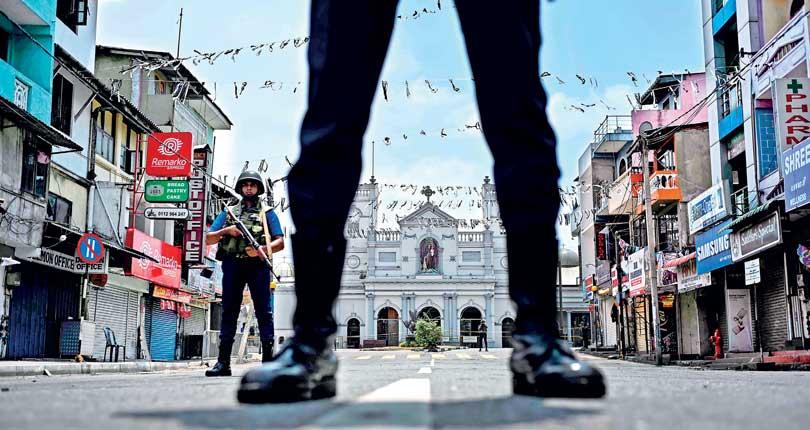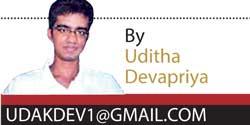Reply To:
Name - Reply Comment

 “Yet across the gulf of space, minds that are to our minds as ours are to those of the beasts that perish, intellects vast and cool and unsympathetic, regarded this earth with envious eyes, and slowly and surely drew their plans against us.”
“Yet across the gulf of space, minds that are to our minds as ours are to those of the beasts that perish, intellects vast and cool and unsympathetic, regarded this earth with envious eyes, and slowly and surely drew their plans against us.”
— H. G. Wells, “The War of the Worlds”
“What’s done is done.”
— John Amaratunga, Press Conference on April the 21st
 When the dust and the rubble settle, and when all the bombs are defused, we will learn more about those who were involved. Until then, we can never know for sure. What we can do now is speculate: make sense of what happened, indict who were responsible for the inactions that led to it, and try to find a way out for us all. The Easter bombings have gone on record as some of the worst since 9/11. The tears, the fatigue, and the anger all point out that we are still trying to come to terms with them.
When the dust and the rubble settle, and when all the bombs are defused, we will learn more about those who were involved. Until then, we can never know for sure. What we can do now is speculate: make sense of what happened, indict who were responsible for the inactions that led to it, and try to find a way out for us all. The Easter bombings have gone on record as some of the worst since 9/11. The tears, the fatigue, and the anger all point out that we are still trying to come to terms with them.
What DID we learn? That terrorism in Sri Lanka is no longer home-grown, but that a global terrorist phenomenon has become domesticated. Domesticated, not last week, but long before any of us could reach a consensus. The truth is that warnings were sounded. The truth is that those who sounded those warnings were (justifiably) taken as extremists whose Cassandra ravings didn’t have to be listened to. The truth is that most of us looked at the messenger and not the message. And the truth is that an awful lot of us now seem to prefer his ravings to the murmurs of this government.
But it wasn’t just these divisive figures who went on tolling the bells. There were others who broadcast the same message they had been broadcasting, without the inflammatory rhetoric. I can point out here Hafeel Farisz’s article on foreign inspired Islamism in 2016 and Ranga Jayasuriya’s article on the growth of the ISIS in the country in 2015, and I can point out some of the comments which greeted the findings of their reports. When Hafeel tried to counter in his writings the spread of Wahabbism, for instance, one writer retorted, “There is no consensus on what the term ‘radicalisation’ means.” Now, of course, we can get a consensus. But at what cost? As of now, more than 340 lives.
The significance of the Easter attacks cannot be undermined. They targeted the Christian, specifically Catholic, population, which belongs concurrently to an ethnic majority and minority (Sinhala and Tamil) on the one hand, and is a religious minority on the other. The terrorists followed, and did their deed in the name of, a faith that has never, as far as history is concerned, majorly clashed with Christianity on our soil.
As such, the attacks cannot be assessed on the basis of the parameters by which previous attacks on ethnic minorities in the country have been assessed; the terrorists have focused entirely on the international dimension, the civilisational clash we are seeing in the West and West Asia (i.e. the Middle East), over the local Buddhist-Muslim clash. One can argue they unleashed their carnage in Sri Lanka because of prior attacks on Muslims by Buddhists, but at the same time one can argue ISIS/DAESH selected this country because of its weakened security apparatus. In any case, the localisation of a centuries-long East-versus-West conflict cannot be denied.
Which is why it comes to no surprise that certain observers are confused and bewildered. Eric Solheim, for instance, tweets that Muslims and Christians are “small minorities” in the country – the implication being what, exactly? “They have been victims of violence in Sri Lanka,” he adds, which is true, except that it is rather irrelevant to the realities and dynamics of the context to which he is referring.
The Christians who were slaughtered that day were not victims of violence unleashed against local minorities by ethnic chauvinists. Mr. Solheim, given his involvement with the ceasefire process between the government and the LTTE, should know that only too well. But that is the narrative I am getting from many foreign commentators, the case of the BBC inviting Dr Thusiyan Nandakumar, only to get the usual account of Sinhala Buddhists murdering Tamils and Muslims, being the most prominent.
And it’s not just foreign observers. The local ones seem to be as confused, if not more so. “[E]ven if the Islamic militants feel that Sri Lanka has done badly by the Muslims,” Jehan Perera informs Padma Rao Sundarji, whose analysis of the carnage, published in the Hindustan Times, is the best from a foreign correspondent so far, “there would be hardly a point in attacking Christians who are also in a minority and often subject to anti-Christian actions at a local level.” You can sense the bewilderment there: why should Christians, attacked by Sinhala Buddhists all the time, be attacked by Muslims?
Given the confusion – which has led commentators to view even a domesticated variant of a global conflict in terms of the majority/minority dichotomy in Sri Lanka – it comes to no surprise that most of those among the civil society activists who stood up strongly against the Dharga Town and Digana attacks, as well as the constitutional coup of last October, are now conspicuous by their silence. To be sure, they have spoken up, and have posted what needs to be posted on social media, but the level of outrage expressed, at the tragic culmination of a process of radicalisation which was ongoing for some time, lacks the immediacy and tenor one got from them with respect to attacks by Sinhala Buddhists against other ethnic, religious, and social groups.
And when activists and commentators were bewildered this way, it followed that MPs would conduct themselves in a ridiculously slipshod manner at odds with their responses to previous episodes of ethnic and religious violence. Among the MPs who were joking around and smirking like the infantilised adults they have always been, for instance, was Lakshman Kiriella, who in the aftermath of the Kandy attacks stated that all Buddhists should apologise to the Muslims.
The truth is that we were unprepared for a tragedy we should have been prepared for. The truth is that violence against ethnicities and measures against terrorism were rationalised and taken in terms of the split between Buddhists and non-Buddhists. In a country that’s at the centre of major geopolitical interests – Western and Asian – this was arguably the most fallacious attitude we could ever project.
And when Islamist extremists were pointed out, when Muslims and non-Muslims alike were demonstrating against the rise of Wahhabism, the protests were shot down. If you’re against what you think to be extremist manifestations of Islam, the stereotype ran, you are against the Muslims of the country. This was seen even in the way the arrest of Abdul Razik, Secretary of the Sri Lanka Thawheed Jamath (from which the National Thawheed Jamath, believed to be responsible for the attacks, split), in 2016 was reported. Here, for instance, is how one journalist saw it:
“Amid fears of renewed religious tensions and ethnically charged hate-speech gaining ground, police yesterday arrested Secretary of Sri Lanka Thawheed Jamath R. Abdul Razik on charges of insulting religion and ‘angering a religious devotee’ during a protest against proposed reform to the Muslim Marriage and Divorce Act (MMDA) last week. The arrest comes in the wake of threats by notorious Bodu Bala Sena Chief Galagodaththe Gnanasara Thero, who promised to attack the majority Muslim suburb of Maligawatte if the IGP failed to take the Secretary of the SLTJ into custody.”(Daily FT, November 17 2016)
In other words, Razik was arrested because of Gnanasara Thera’s threats, and he needn’t have been taken into custody it if weren’t for them!
The tragedy we succumbed to at the time was that we conflated the two – condemnation of Islamic extremism was seen as anti-Muslim rhetoric spewed by the likes of the Thera – and continued to project this narrative right down to the early hours of the Easter attacks. (I should know, since even I believed the bombings were carried out by those connected with the Kandy attacks.) This conflation was what the security personnel were forced to swallow for years, thereby framing terrorism as an exclusively domestic phenomenon. It hence comes to no surprise that even when Vice President of the Muslim Council, Hilmy Ahamed, warned intelligence officials about the NTJ, he was ignored.
So who are we to blame? First and foremost, the politicians.
Secondly, the activists who neglected to stand firmly with those who were criticising the rise of radicalism. And thirdly, many of those (not all) who wrote to the papers, gave voice-cuts, and perpetuated the myth that those who criticised the practices of extremist minority groups were caving into Sinhala Buddhist chauvinism.
As of now, more than 340 are dead. And we have these people to thank for what, in part at least, led to it.